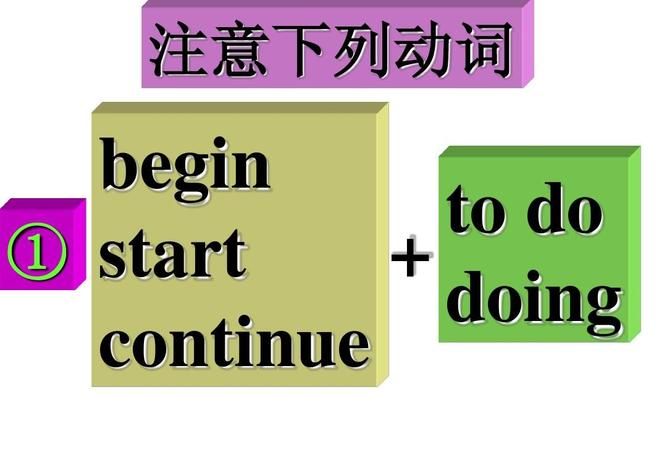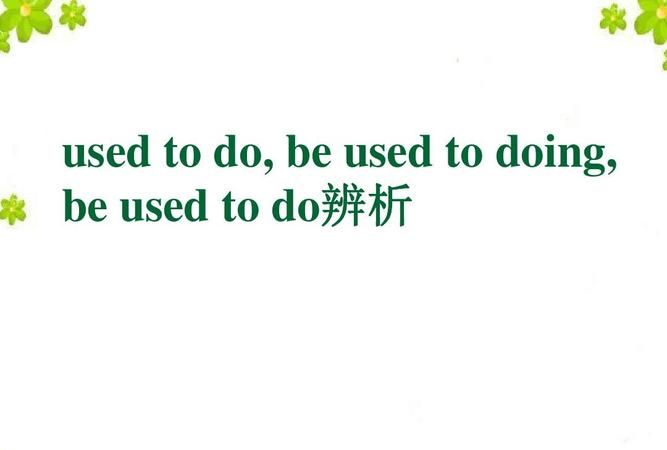本文目录
to do 和doing的区别做主语的例子
to do主要用来表示一次性具体性将要发生性的行为。其逻辑主语暗中有所指。doing主要用来表示经常性、习惯性、抽象性发生的行为。其逻辑主语暗中无所指。
动名词和不定式做主语的不同点
1.不定式做主语常表示具体的某一动作;表示泛指或一般的抽象的概念时,多用动名词,如:
Walking is a good form of exercise for both young and old.
2.在”There/It +be+ no use(good/help/need)”之后常用动名词做主语,而少用不定式,如:
It/There is no use crying over the split milk.
It/There is no help taking this medicine.
但是如果该句型中用了for引出不定式的逻辑主语,就只能用不定式,如:
There is no good for us to do that exercise.
3.不定式可以和when, where, how, what, whether等连用,在句子中做主语,宾语和表语,而动名词则不能,如:How to solve the problem is a hot potato.
to do,一次性的动作。doing经常的行为。
不定式做主语一般指具体的某一动作,而动名词做主语多是泛指。如:Learning is necessary for all of us in this society。

to do和doing的区别是什么
learn to do和learn doing的区别:
1、learn to do sth. 学着去做某事(在心里打算好了准备去学,还没有去)强调具体某次的动作。
2、learn doing sth. 学习做某事(已经在学习了,现在进行时 ) 强调抽象的动作。
拓展资料
learn to do
1、If you can learn to do this, you can make good decisions.
如果你可以学会做到这些,你就可以做出明智的决定。
2、"Where did you learn to do this", I asked them.
“你们在哪里学会做这些的?”我问他们。
3、If I were a freshman I should learn to do such things early.
如果我是大一学生,我会早学会做这样的事情。
4、They are just things you learn to do as you grow up.
它们只是您在成长过程中学会做的事。
5、If I do it for you how will you ever learn to do it yourself?
如果妈妈替你做了,那你自己如何能学会呢?
learn doing
1、We need to learn from doing, by trial-and-error.
我们需要通过尝试和犯错,从实践中学习。
2、There's no way you will start if you say you "need to learn before doing".
如果你说“我要先学习一下再开始做”那么你永远不会真正开始。
3、You're a student; you know how important it is to learn by doing.
作为一个学生你知道实践学习多重要。
4、One reason I prefer to learn by doing is because I believe that experience is the best teacher.
我比较喜欢通过实践学习的其中一个理由是,我认为经验是人最好的老师。
5、For the things we have to learn before we can do them, we learn by doing them.
我们在做之前需要学习,在学习的过程中去做。

句首用to do和doing有什么区别
区别一:两者发音不同。
to do:英 [tə du] 美 [tu du,tə du]
doing:英 [ˈdu:ɪŋ] 美 [ˈduɪŋ]
区别二:两者基本含义不同。
to do:基本含义为“去做”。
doing:基本含义为“正在做”。

区别三:两者用法不同。
to do:afford to do sth负担得起做某事,agree to do sth同意做某事,arrange to do sth安排做某事,ask to do sth要求做某事,beg to do sth请求做某事,care to do sth想要做某事,decide to do sth决定做某事,类似的固定用法有很多。
doing:advise doing sth建议做某事,allow doing sth允许做某事,risk doing sth冒险做某事,stop doing sth停止做某事,keep doing sth保持做某事,be afraid of doing sth害怕做某事,imagine doing sth想象做某事,类似的固定用法有很多。
不是所有to do都做宾补。
doing在句中可充当主语、谓语、宾语、状语、表语等成分。
todo和doing有什么区别秒懂百科
to do sth 表示准备做某件事 doing sth 表示正在进行做得时候
start to do sth.(begin / start to do sth.)和sart doing sth.(begin / start doing sth.)都表示“开始做某事”,start to do sth 意思是指“开始去做某事(接着做前面那件事)”,有“潜在的可能”;start doing sth 意思是指“开始做某事(做另一件事)”,有“实际进行”的意思.
具体使用方面的区别:
1.表示开始一项长期活动或开始一种习惯时,使用doing.
(此时start/begin doing多用于表示开始一项较长时间或经常性的活动)
How old were you when you first started playing the guitar?你几岁时开始弹吉他?
2. begin, start用进行时时,后面动词用不定式to do
I was beginning to get angry.我开始生起气来。
The plaster was starting to fall from the walls. 墙上的灰泥开始脱落了。
3. 在attempt, intend, begin, start 后接know, understand, realize这类表示心理状态或精神活动的动词时,常用不定式to do。
I begin to understand the truth。我开始明白真相。
Mary started to guess what is in the bag. 玛丽开始猜包里有什么东西了。
4.物作主语时(句子主语是物不是人的时候,后用start to do sth)
The ice started to melt. 冰开始融化了。

以上就是关于todo和doing的用法区别 ,to do 和doing的区别做主语的例子的全部内容,以及todo和doing的用法区别 的相关内容,希望能够帮到您。

